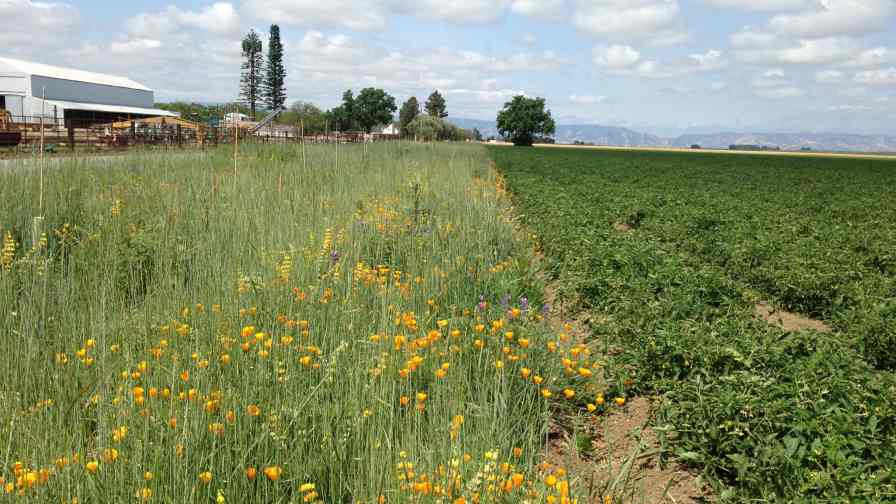Attract Pollinators To Your Farm

Using attractants such as wildflower mixes and shrubs ensures that bees have access to a steady source of flowering plants to keep them on your farm even during the off season. Photo credit: Rachael Long
Pollination is a hot topic these days with the worldwide decline in honeybees and no clear solution in sight. As scientists continue the search for methods to revive dwindling bee populations, growers are still challenged with getting honeybees and other native pollinators to their farms to ensure adequate crop pollination and healthy yields.
Using attractants such as wildflower mixes and shrubs ensures that bees have access to a steady source of flowering plants to keep them on your farm even during the off-season. Furthermore, providing a protected habitat for pollinators to nest helps guarantee they will stay on and revisit your farm season after season.
The Case For Native Pollinators
Native pollinators may provide an added benefit to growers who have traditionally relied on the pollination services of honeybees, says Logan Rowe from the Department of Entomology at Michigan State University (MSU).
“There’s research out there that shows a synergistic effect of having both honeybees and native bees in cropping systems, and this can turn into an increase in crop yields,” Rowe explains.
“By including native bees of different sizes that have different ways of moving around the cropping system, it essentially causes more movement of all of these pollinating insects, and more movement means more flowers being visited.”
Planting wildflower mixes, shrubs, or a combination of the two is an excellent way to attract pollinators to your farm and keep them there. When it comes to flowers, your best bet is to pick flowers that blossom throughout the season to ensure you’re providing a consistent supply of resources.
“A lot of times, growers will have a pulse of resources that are abundantly available, and then they’ll just go away. Bees need a consistent supply of pollen and nectar in order to reproduce and boost their health, and the main way to attract them is to plant flowers,” Rowe says.
Choosing Your Flowers
In the MSU labs, most of the floral enhancements Rowe has seen are placed directly adjacent to the cropping field, which allows pollinators to come out of their native habitat and spill over into the cropping system.
Plants that bloom frequently or that have a high floral area tend to be the most attractive to pollinators, and Rowe cites sunflower, goldenrods, bee balm, and black-eyed Susans, as being some of the most attractive to them.
He also suggests using a seed mix that has plants that bloom during different times of the year and throughout the duration of the summer. Selecting regionally appropriate plants also is key when attracting native pollinators, and Rowe cautions growers not to skip this step.
“Regions do matter, and to what scale regions matter the most is still up in the air. It also has a lot to do with soil types. Some plants do better in sandier, drier soils, and others have good water-retaining abilities. It’s important to recognize the preferred habitat for a particular plant, and use that as a basis to decide whether or not to plant it in a certain area,” Rowe explains.
Using Shrubs
Wildflowers are not the only source of nectar available for pollinators. Flowering shrubs also can be a steady source of nutrition for bees, and Rachael Long, Farm Advisor with University of California Cooperative Extension in Yolo County, has researched their pollination benefits at length.
“My area of work is putting in perennial shrubs that produce a lot of nectar and pollen on field edges so that you’re not taking land out of production. The shrubs aren’t big enough to cause any adjacent competition for light, nutrients, and water for the crop,” Long says.
According to Long’s research, all you need is one strip of plants along one field edge and pollinators will move almost 600 feet into the cropping system.
“Growers that have these edge rows on their farms have higher numbers of beneficial insects and higher numbers of native bees in the adjacent crops. We’ve also documented that you get a little bit better pest control from the natural enemies,” she says.
Different than wildflower mixes, shrubs are permanent plantings; and in California, Long says most growers are using native, drought-tolerant shrubs. They are using a mixture of shrubs including western redbud, coffeeberry, California lilac, toyon, California buckwheat, and coyote brush that are all adapted to California’s dry conditions.
Protecting Their Home
Another way to ensure pollinators are warmly welcomed onto your farm is to provide a habitat for them to nest. Long says there are a variety nesting spaces pollinators may choose including in the ground, twigs, tree logs, and above-ground crevices.
“Leafcutter bees, for example, are going to be aboveground nesters. You’ll also have a lot of belowground nesters like squash bees and sunflower bees that are important, too,” Long says.
For bees that nest belowground, one of the most important things you can do to protect their habitat is refrain from disking it under, she says. Other things to remember include to avoid spraying the nesting area with pesticides, and when you do spray, time sprays for the early morning to avoid impacting the bees when they are out foraging for resources.
Growers also can provide man-made habitats for pollinators such as nesting boxes. In Rowe’s lab at MSU, the nesting boxes are filled with paper straws, which pollinators, such as the mason bee and the leafcutter bee, take residence in.
“If the landowner puts those nesting boxes around the agricultural landscape, it’s possible that bees that are native and are already in the landscape will find them, nest in them, and the following season they’ll emerge ready to do their job,” he explains.
Other ways to provide habitat for bees include providing an area on your farm with bare soil for ground nesting bees and to provide an area with wet ground or mud, as some bees, like mason bees, actually use mud to build their nests, Rowe explains.
Available Funding
If you’re interested in creating a habitat for pollinators at your operation, funding options are available. A major part of the 2014 Farm Bill was aimed at encouraging the development of habitat for native and managed pollinators, and several grant programs have been developed as an offshoot.
The Natural Resources Conservation Services offers opportunities such as the Environmental Quality Incentives Program, which provides financial and technical assistance to growers, helping to offset the costs of implementing conservation practices, which can help protect pollinator habitats.
For a longer list of programs that can provide funding in this area, visit https://is.gd/pollinators.









